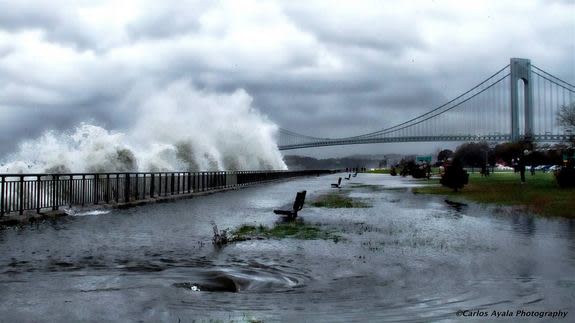Will Sandy Change the Climate Change Conversation? - If you were listening to New York Gov. Andrew Cuomo's press briefing Tuesday (Oct. 30) as New York City began to tally the damage from Hurricane Sandy, you may have been surprised by what you heard.
"There has been a series of extreme weather incidents. That is not a political statement. That is a factual statement," Cuomo said. " Anyone who says there's not a dramatic change in weather patterns, I think, is denying reality."
Yesterday he added, "I think part of learning from this is realizing that climate change is a reality."

Former President Bill Clinton told a crowd Tuesday: "All up and down the East Coast, there are mayors ... being told, 'You've got to move these houses back away from the ocean. You've got to lift them up. Climate change is going to raise the water levels on a permanent basis. If you want your town insured, you have to do this.'" Add to the mix Mayor Michael Bloomberg, who endorsed Barack Obama for president on Thursday (Nov. 1), saying Obama is the better candidate to deal with climate change, which he said may have contributed to the superstorm.
High-profile figures like Bloomberg, Cuomo and Clinton speaking candidly and practically about climate change suggests a change of pace among public officials. But will the dialogue on extreme weather and climate that has emerged in Sandy's wake alter the national conversation (or lack thereof) on climate change? Or will that discussion recede with Sandy's floodwaters and the week's news cycle?
What made Sandy so destructive?
Hurricane Sandy was an unusually large and destructive storm, breaking records in rainfall, flooding, barometric pressure and, potentially, costs. The storm surge breached New York City's hundred-year-old sea walls and flooded the underground network of subway tunnels — the most destructive event in the subway system's 108-year history, according to Metropolitan Transportation Authority chairman Joseph Lhota.
But how much of the storm's size and devastation can we tie to climate change?
Experts don't have the answer to that question. They do say, however, that climate change had at least some influence.
"This was a complex storm, so we do need to be cautious about linking it to climate change," said Jonathan Foley, an ecosystem researcher who is director of the University of Minnesota's Institute on the Environment. "Only some of its components may have been due to climate change."
The storm had several ingredients, Foley explained. Sandy's late-season formation may have been influenced by a shifting climate, but its meet-up with an early North American winter storm had no climate change connection. A high-pressure blocking event, which may have been climate change-related, steered the storm toward the East Coast rather than out to sea. Unusually high tides amplified Sandy's storm surge and flooding, but the tides had nothing to do with climate change. And the fact that those four events happened simultaneously was just an unfortunate coincidence.
Warmer temperatures, which allowed the storm to carry more moisture, and higher sea level are likely to have amplified Sandy and its effects, said Michael Mann, a climate researcher at Pennsylvania State University. The 13-foot (4 meters) coastal surge, which includes both storm surge and high tide, in New York City's Battery Park was the highest in at least two centuries. The higher sea level — a foot higher than when the city's protective sea walls were built a century ago — can be attributed to climate change, Mann said.
"Someone set the fire with meteorology, but climate change added the fuel," Foley said.
Sandy and the climate conversation
The message that climate change did play a role in Hurricane Sandy isn't getting the attention it should, Mann said.
"The climate change discussion needs a tipping point — I call it a Cuyahoga River moment," Mann said, referring to the polluted Ohio river that caught fire in 1969 and sparked an environmental movement.
Foley agreed. "We're having the same conversation we've been having since the 1988 drought, the 1993 floods, Hurricane Katrina, the heat waves in Europe. Public attention seems to max out at a couple weeks."
Many have noted the near-absence of a climate discussion in the 2012 presidential race. Foley said that's not surprising because it's a no-win proposition for both candidates. President Barack Obama already is seen having the support of most voters who are concerned about climate change, and the matter doesn't seem to be a major concern for Mitt Romney's supporters.
"When one political party has the official position that climate change is a hoax, when we're politically divided as to whether we should even accept the science, it's difficult to have a meaningful discussion," Mann said.
But Foley hopes that, after the election, Hurricane Sandy will spur a long-term discussion about climate change and extreme weather events.
"This is an opportunity to have a conversation about how vulnerable we are to natural disasters," he said. "We need a good, balanced discussion, but with a sense of urgency."
For New York's governor, that sense of urgency may have already arrived.
"A fundamental rethinking of our built environment," and the long-term modifications that might be needed to protect New York City from coastal flooding, "is a massive, massive undertaking," Cuomo said yesterday. "But it is a conversation I think is overdue, and a conversation I think we should begin." ( LiveScience.com )
Blog : Paying The Highest
No comments :
Post a Comment